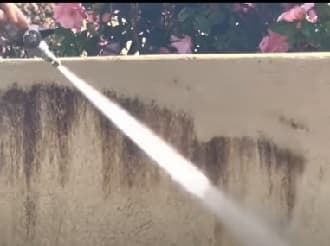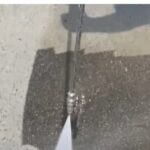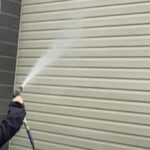As an Amazon Associate, this site earns commissions from qualifying purchases. For more information click here.
Stucco is unique in that it can last for decades but is also delicate and can damaged through improper cleaning. It needs to be maintained regularly but use the wrong method and you could wreck the surface. In this guide I will show the safest and most efficient way to pressure wash stucco.
Use the soap tip for the detergent and a 40 degree tip for rinsing. You may also use a 25 degree tip for spraying, but make sure you are 12-30 inches away from the stucco surface.
Pressure washers are powerful, but with the right approach it can be used on stucco. I have tried different ways to clean and pressure washers are by far the fastest and most effective.
Pressure Wash Stucco Step by Step
It takes more than just the right pressure washer nozzle though. You have to take the proper approach. Here’s how.
Step 1
Inspect the surface for cracks and fix any that you see. If you don’t repair, the water from the pressure washer will seep into the walls. This can weaken the structure because mold could appear. If there is no damage, you can proceed to the next step.
Step 2
Get your pressure washer ready. The optimum PSI setting is 1500-2800. I suggest starting with 1800 PSI and increase gradually if the dirt does not fly off.
You can use a 25 or 40 degree nozzle. Pressure washers today like the PowRyte 3800 have a quick connect feature so you can swap nozzles easily.
Because stucco is delicate, I suggest starting off with a 40 degree tip and 1500 PSI. Increase the PSI and use a 25 degree tip if there is too much dirt. You can also check out this guide on how to pressure wash a house.
Stand 12-30 inches from the surface and start spraying from top to bottom at a 45 degree angle. This is going to remove the dirt without damaging the surface.
Step 3
The next step is to apply the detergent. There are a lot of products to choose from, and personally I like Simple Green Oxy Solve. It is safe for stucco and you only need a small amount to remove dirt.
If your initial spray removed most of the grime, soap and water is enough. Pour the soapy mix into the container and switch to the soap nozzle.
Apply the detergent from the bottom and work your way up. Focus on areas where the initial spray failed to remove the debris. Leave the solution for 15 minutes before rinsing.
If there is mold or mildew, use Oxy Solve as it is compatible with pressure washers. Follow the package instructions and spray the surface. Let the solution rest for 15 minutes.
Step 4
If things go well, the detergent will clean the entire surface. For stubborn dirt you’ll have to do some scrubbing though.
You can use any hard bristle brush or other scrubbing tool. How long this takes depends on the amount of dirt and how long it’s been there.
You’re probably wondering: why not use the yellow (15 degree) or red (0 degree) tips? Won’t they eliminate grime faster?
Yes, but both tips (especially the red one) is going to destroy the stucco as well. Those nozzles are too heavily concentrated and will rip through the surface.
While scrubbing is slow, it’s not going to damage your stucco. You can make it easier by cleaning in sections. Focus on one area at a time, brushing thoroughly before moving onto the next.
Step 5
The last step is rinsing. Put the 25 or 40 degree nozzle back on. Stand 12-30 inches from the stucco and spray.
Wash thoroughly to avoid leaving any detergent behind. Spray from top to bottom as you did before. Just like when scrubbing, it helps to divide the walls into smaller sections.

Is it Safe to Pressure Wash Stucco?
Yes, as long as you follow the safety guidelines given here. The most important are:
- Use a 25 or 40 degree nozzle
- PSI range should be 1500-2800 maximum
- The nozzle should be 12-30 inches from the surface
If this is your first time to pressure wash stucco, use a low PSI and a 40 degree tip. Stand 30 inches away and only move closer if it’s unable to wash the dirt off.
Due to its delicate properties, you have to spray in sections. Don’t linger on a part longer than you have to.
What is the Best Pressure Washing Technique for Stucco?
Spray from top to bottom. Apply detergent from bottom to top. Rinse from top to bottom. This method also works for other types of surfaces as well.
The way you pressure wash stucco isn’t that different from other surfaces, except you use lower psi and a wide nozzle. Assuming there are no cracks or gaps, pressure washing won’t cause any harm.
How Often Should I Pressure Wash Stucco?
Cleaning every 12 months is the best way to keep stucco clean and well preserved. This is only a general guideline though, as you should be able to tell if the walls need more frequent or less cleaning.
No matter how often you pressure wash, always inspect the surface first. Cracks are the most obvious signs of damage, but keep an eye out for chips, gaps and holes in the surface.
To fix any cracks, apply caulk and top it with sand. Wait for it to dry and you can proceed with the cleanup.
Safety Guidelines
Pressure washers can cause bodily harm if you’re not careful. Wear eye goggles, long sleeve clothing, shoes and pants.
If you haven’t cleaned the walls in a while, it’s a good idea to focus on the general area first. Sweep debris if any in the vicinity to avoid slipping on them.
Never use the yellow and red nozzles. Use only the 25 and 40 degree tips. The more powerful nozzles will tear a hole in the stucco and make things worse.
FAQ
The stucco stains are hard to remove. What should I do?
If you started at 1500 PSI and a 40 degree tip, switch to 25 degrees and increase the PSI to 2000. You can move it up to 2800 maximum. You may also spray as near as 12 inches to the stucco.
If that doesn’t work, use a rotating brush attachment. It should be more effective in taking out embedded dirt. It also works on mildew and mold.
You can also use cleaning detergents or prepare your own mix. Mix a couple tablespoons of dish soap, half a cup of Borax and two gallons of water.
You can also use bleach instead of Borax for really tough stains. Use this only if other cleaning solutions do not work.
Can pressure washing remove stucco rust?
Yes, but you must only use products that are specifically for stucco rust. Other removers might be too harsh and damage the stucco.
A brush is the best option for rust stains. You want to be thorough but gentle to avoid scratching the surface. Once you have removed the stains, rinse well.
What is the best way to remove mildew/mold from stucco?
There are several cleaning solutions for mildew and mold available. Look for one that is stucco safe and made for pressure washer use. Spray it on the surface following the product instructions and rinse thoroughly.
If you prefer a DIY approach, mix equal parts warm water and Borax. You can substitute bleach or dish soap for Borax too. Spray, leave it for 10 minutes and rinse.
How do I remove black and/or white stains on stucco?
White stains are probably efflorescence, salt deposits which can appear in stucco and other surfaces. A mixture of vinegar and water should remove it.
Equal parts for each is fine, though you may want to increase the vinegar for hard to remove stains.
Black stains are either mold or algae. Bleach or dish soap and water will work as well as several mold/algae cleaning products. Have a brush in hand in case you need to scrub some off.
Is stucco easy to clean?
A pressure washer makes stucco cleaning easier. It is more efficient than a garden hose and uses less water. Because pressure washers remove a lot of the dirt, grime and stains, you only have to do a limited amount of scrubbing.

I love the outdoors and all the tools for maintaining gardens, yards and lawns. The only thing I am more passionate about is sharing what I know about garden and outdoor equipment.


